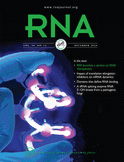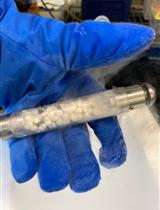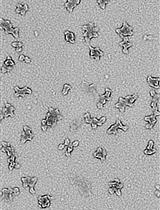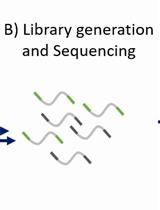- EN - English
- CN - 中文
HPLC Analysis of tRNA‐Derived Nucleosides
HPLC分析tRNA衍生核苷
发布: 2025年02月20日第15卷第4期 DOI: 10.21769/BioProtoc.5213 浏览次数: 1671
评审: Ritu GuptaJaveena HussainAnonymous reviewer(s)
Abstract
Transfer RNAs (tRNAs), the essential adapter molecules in protein translation, undergo various post-transcriptional modifications. These modifications play critical roles in regulating tRNA folding, stability, and codon–anticodon interactions, depending on the modified position. Methods for detecting modified nucleosides in tRNAs include isotopic labeling combined with chromatography, antibody-based techniques, mass spectrometry, and high-throughput sequencing. Among these, high-performance liquid chromatography (HPLC) has been a cornerstone technique for analyzing modified nucleosides for decades. In this protocol, we provide a detailed, streamlined approach to purify and digest tRNAs from yeast cells and analyze the resulting nucleosides using HPLC. By assessing UV absorbance spectra and retention times, modified nucleosides can be reliably quantified with high accuracy. This method offers a simple, fast, and accessible alternative for studying tRNA modifications, especially when advanced technologies are unavailable.
Key features
• A streamlined protocol for purifying total tRNAs from yeast cells.
• Adaptable for other RNA species and organisms, provided sufficient input material.
• Enables the quantification of approximately 20 types of tRNA modifications.
• Offers a cost-effective and rapid alternative for analyzing tRNA modifications by HPLC method.
Keywords: tRNA modifications (tRNA修饰)Background
The landscape of RNA modifications across the transcriptome, known as the epitranscriptome, is receiving increasing attention. To date, over 170 distinct types of RNA modifications have been identified [1]. These modifications play pivotal roles in regulating all aspects of RNA biology, from transcription and processing to degradation, ultimately influencing cell fate. Among all RNA species, tRNA stands out as one of the most extensively modified, with an average of 13 modifications per molecule [2]. These modifications encompass a wide range of chemical alterations, from simple methylations to complex structures like pseudouridylation. Deficiencies in tRNA modifications or the enzymes responsible for them have been linked to various human diseases, including neurological disorders and cancer [3]. Thus, studying tRNA modifications is critical for advancing our understanding of human health.
Various methods are available for the quantitative analysis of tRNA modifications. Among these, mass spectrometry, regarded as the gold standard for tRNA modification identification, is widely used in the field. Additionally, emerging high-throughput sequencing technologies, such as mim-tRNAseq and nano-tRNAseq, are revolutionizing the study of tRNA modifications by enabling single-nucleoside resolution analysis at the epitranscriptome level [4,5]. Among the classic methods, for decades HPLC has been a cornerstone technique for analyzing modified nucleosides, remaining a valuable tool in RNA modification research. Here, we present a modified version of the protocol originally described by Gehrke et al. [6]. This updated protocol employs a C30 reverse-phase column coated with a 30-carbon-long alkyl chain, offering a more hydrophobic separation phase compared to the previously used C18 column, which features an 18-carbon-long alkyl chain. Additionally, we provide a streamlined protocol for purifying tRNAs from yeast cells using diethylaminoethyl cellulose (DE52) for subsequent HPLC analysis. The cellulose matrix exhibits weak ion exchange properties, enabling the separation of RNAs of different sizes under varying salt concentrations [7]. With this approach, we can reliably separate and identify more than 20 types of modified nucleosides with high accuracy and confidence.
Materials and reagents
Biological materials
1. Saccharomyces cerevisiae
Reagents
1. Synthetic complete yeast growth medium (Formedium, catalog number: CSC0201)
2. Nuclease-free water (Invitrogen, catalog number: 10977-035)
3. NaCl (Sigma-Aldrich, catalog number: S9888)
4. Water-saturated phenol (AppliChem, catalog number: A1624)
5. Chloroform (Sigma-Aldrich, catalog number: 650498)
6. Ethanol (Sigma-Aldrich, catalog number: 1009861000)
7. 1 M Tris-HCl, pH 7.4 (Santa Cruz, catalog number: SC-301950)
8. 1 M Tris-HCl, pH 8.3 (Fisher Scientific, catalog number: T1083)
9. Qubit RNA Broad Range kit (Thermo Fisher, catalog number: Q10210)
10. Isopropanol (Sigma-Aldrich, catalog number: 1096341011)
11. DMSO (Sigma-Aldrich, catalog number: 34869)
12. Diethylaminoethyl cellulose (DE52) (Biophoretics, catalog number: B45059)
13. Nuclease P1 (Sigma-Aldrich, catalog number: N8630)
14. Bacterial alkaline phosphatase (BAP) (Sigma-Aldrich, catalog number: P4252)
15. ZnCl2 (Sigma-Aldrich, catalog number: 39059)
16. 1 M sodium acetate, pH 5.0 (Thermo Fisher, catalog number: J60964.AK)
17. NH4H2PO4 solution (Sigma-Aldrich, catalog number: 216003)
18. NH4OH solution (Sigma-Aldrich, catalog number: 221228)
19. H3PO4 solution (Sigma-Aldrich, catalog number: 695017)
20. Methanol (Honeywell Chemicals, catalog number: 34966)
21. Acetonitrile (Honeywell Chemicals, catalog number: 34881)
Solutions
1. 0.9% NaCl (w/v)
2. 10 mM ZnCl2
3. DE52 binding buffer (see Recipes)
4. DE52 solution (see Recipes)
5. tRNA elution buffer (see Recipes)
6. Nuclease P1 solution (see Recipes)
7. HPLC solvent A (see Recipes)
8. HPLC solvent B (see Recipes)
9. HPLC solvent C (see Recipes)
Recipes
1. 0.9% NaCl
Store at RT.
| Reagent | Final concentration | Amount |
|---|---|---|
| NaCl | 0.9% (w/v) | 9 g |
| Nuclease-free H2O | n/a | 1,000 mL |
2. 10 mM ZnCl2
Store at -20 °C. Stable for at least five years.
| Reagent | Final concentration | Amount |
|---|---|---|
| 0.1 M ZnCl2 | 0.01 M | 100 μL |
| Nuclease-free H2O | n/a | 900 μL |
3. DE52 binding buffer
Store at RT. Stable for at least one year.
| Reagent | Final concentration | Amount |
|---|---|---|
| 1 M Tris-HCl, pH 7.4 | 0.1 M | 100 mL |
| NaCl | 0.1 M | 5.844 g |
| Nuclease-free H2O | n/a | 900 mL |
4. DE52 solution
Store at 4 °C. Stable for at least six months.
| Reagent | Final concentration | Amount |
|---|---|---|
| DE52 | 0.33 g/mL (w/v) | 100 g |
| DE52 binding buffer | n/a | 300 mL |
5. tRNA elution buffer
Store at RT. Stable for at least one year.
| Reagent | Final concentration | Amount |
|---|---|---|
| 1 M Tris-HCl, pH 7.4 | 0.1 M | 100 mL |
| NaCl | 1 M | 58.44 g |
| Nuclease-free H2O | n/a | 900 mL |
6. Nuclease P1 solution
Store at -20 °C. Stable for at least one year.
| Reagent | Final concentration | Amount |
|---|---|---|
| Nuclease P1 | >250 units /1 mL | 1 vial (>250 units) |
| 1 M sodium acetate, pH 5.0 | 30 mM | 30 μL |
| Nuclease-free H2O | n/a | 970 μL |
7. HPLC solvent A
Prepare before use. Adjust pH to 5.3 with NH4OH and H3PO4.
| Reagent | Final concentration | Amount |
|---|---|---|
| 1 M NH4H2PO4 | 0.01 M | 10 mL |
| Methanol | 2.5% (v/v) | 25 mL |
| Milli-Q H2O | n/a | 965 mL |
8. HPLC solvent B
Prepare before use. Adjust pH to 5.1 with NH4OH and H3PO4.
| Reagent | Final concentration | Amount |
|---|---|---|
| 1 M NH4H2PO4 | 0.01 M | 10 mL |
| Methanol | 20% (v/v) | 200 mL |
| Milli-Q H2O | n/a | 790 mL |
9. HPLC solvent C
Prepare before use.
| Reagent | Final concentration | Amount |
|---|---|---|
| 1 M NH4H2PO4 | 0.01 M | 10 mL |
| Acetonitrile | 35% (v/v) | 350 mL |
| Milli-Q H2O | n/a | 640 mL |
Laboratory supplies
1. Disposable gloves
2. Milli-Q water
3. 15 mL centrifuge tubes (Corning, catalog number: 430052)
4. 50 mL centrifuge tubes (Corning, catalog number: 352070)
5. 1.5 mL micro-centrifuge tubes (Eppendorf, catalog number: 0030120086)
6. 1 L glass bottles (Thermo Fisher, catalog number: FB8001000)
7. HPLC sample tube (Waters, catalog number: 186000273)
8. HPLC sample tube cap (Waters, catalog number: 186000305)
9. HPLC sample insert (Waters, catalog number: WAT094170)
10. Polypropylene column (Bio-Rad, catalog number: 731-1550)
11. Reversed phase aqueous C30 column (Phenomenex, catalog number: CH0-5690)
Equipment
1. Single channel pipette set (Sigma-Aldrich, catalog number: EP3123000918-1EA)
2. Qubit fluorometer (Thermo Fisher, catalog number: Q33238; or similar)
3. 30 °C shaking incubator (INFORS-HT, model: Ecotron; or similar)
4. Cell density photometer (Implen, model: DiluPhotometer; or similar)
5. Centrifuge for 50 mL conical tube (Heraeus, model: Multifuge X3R; or similar)
6. Benchtop centrifuge for 1.5 mL centrifuge tube (Eppendorf, model: 5427R; or similar)
7. Benchtop mixer (Heidolph Instrument, model: 545-10000-00; or similar)
8. pH meter (Mettler Toledo, model: 30266626; or similar)
9. HPLC separation module (Waters, model: 2695)
10. PDA detector (Waters, model: 2996)
Software and datasets
1. Empower 3 FR4 (Waters, Version 3 Feature Release 4, released in 2017); requires a license
Procedure
文章信息
稿件历史记录
提交日期: Nov 30, 2024
接收日期: Jan 5, 2025
在线发布日期: Jan 19, 2025
出版日期: Feb 20, 2025
版权信息
© 2025 The Author(s); This is an open access article under the CC BY license (https://creativecommons.org/licenses/by/4.0/).
如何引用
Chen, X. and Xu, F. (2025). HPLC Analysis of tRNA‐Derived Nucleosides. Bio-protocol 15(4): e5213. DOI: 10.21769/BioProtoc.5213.
分类
生物化学 > RNA > mRNA翻译
分子生物学 > RNA > RNA 提取
微生物学 > 微生物生物化学 > RNA
您对这篇实验方法有问题吗?
在此处发布您的问题,我们将邀请本文作者来回答。同时,我们会将您的问题发布到Bio-protocol Exchange,以便寻求社区成员的帮助。
提问指南
+ 问题描述
写下详细的问题描述,包括所有有助于他人回答您问题的信息(例如实验过程、条件和相关图像等)。
Share
Bluesky
X
Copy link












